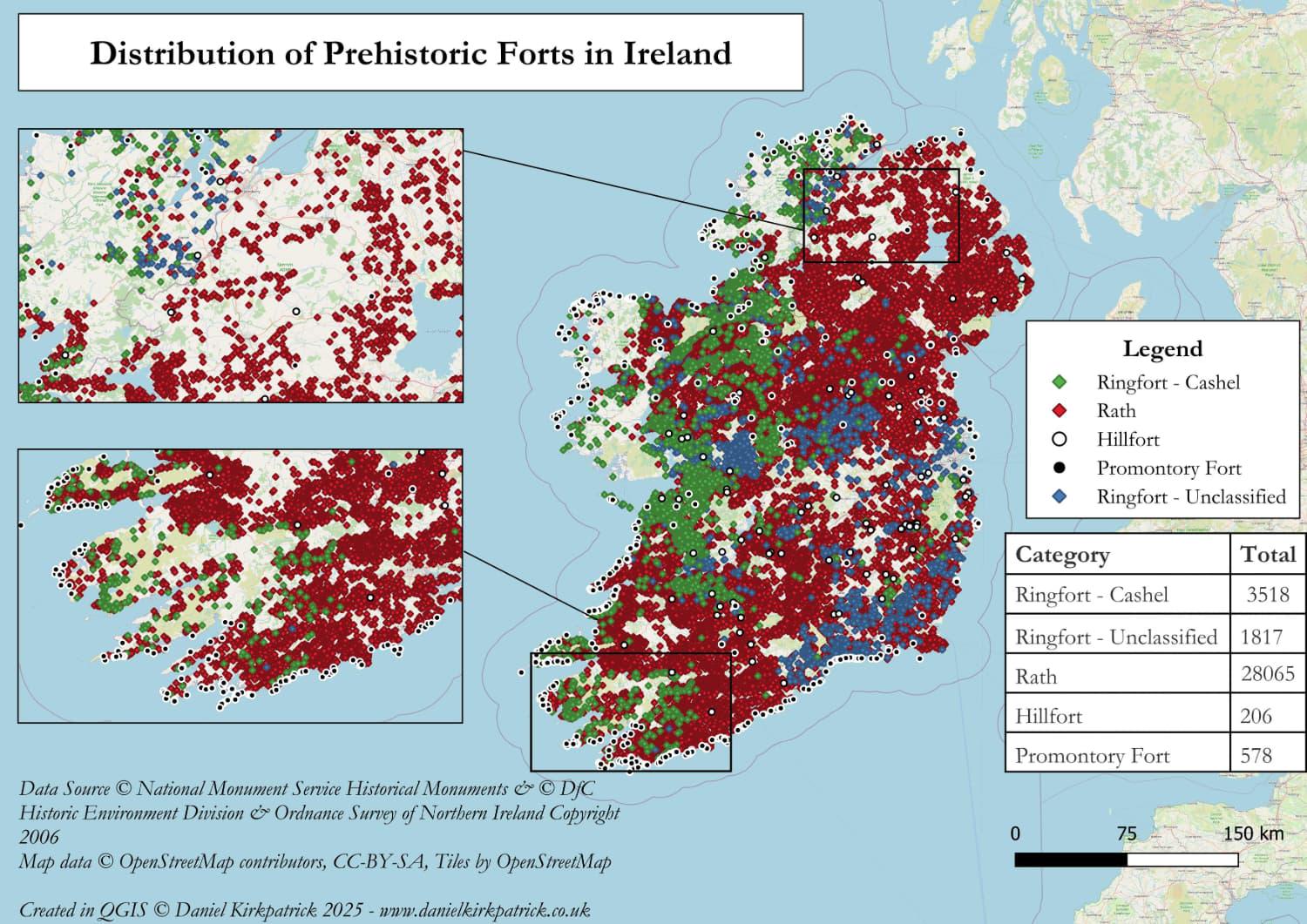Map of Prehistoric Forts in Ireland


Alex Cartwright
Senior Cartographer & GIS Specialist
Alex Cartwright is a renowned cartographer and geographic information systems specialist with over 15 years of experience in spatial analysis and data...
Geographic Analysis
What This Map Shows
The map titled "Distribution of Prehistoric Forts in Ireland" provides a comprehensive overview of the locations and concentration of ancient forts scattered throughout the Irish landscape. These structures, primarily dating from the Iron Age and earlier, offer a glimpse into the historical and cultural significance of Ireland’s past. The visualization highlights not only the density of these forts but also their geographical distribution across different regions of the country, showcasing a rich tapestry of history waiting to be explored.
Deep Dive into Prehistoric Forts
Prehistoric forts are fascinating remnants of ancient societies, serving as both defensive structures and symbols of power and community. In Ireland, these forts—often referred to as ringforts, hillforts, or promontory forts—vary in size, shape, and construction method, reflecting the diverse strategies of early Irish inhabitants.
Interestingly, many of these forts are circular or oval in shape, typically surrounded by a bank or ditch. This design not only provided a formidable defensive barrier against potential invaders but also defined communal space for gatherings and activities. The construction of these forts often utilized local materials, with stone or earth being the primary components. Some of the most notable types include the stone-built cashels in the west and the earthen ringforts prevalent throughout the countryside.
What’s fascinating is the sheer number of these structures; it is estimated that there are over 30,000 recorded prehistoric sites in Ireland, with a substantial portion being forts. These structures are not just scattered randomly; their distribution often correlates with ancient trade routes, resources, and strategic locations for defense against rival tribes or invaders.
Moreover, archaeological studies have shown that these forts were not static. Many were continuously inhabited, evolving over centuries as communities grew and their needs changed. For example, the famous Dún Aonghasa on the Aran Islands is not only a hillfort but also offers breathtaking views that would have been advantageous for monitoring the surrounding area. This multifunctional use of space underscores the importance of these forts in the social and economic life of early Irish societies.
Regional Analysis
Examining the map, we can see distinct regional patterns in the distribution of prehistoric forts across Ireland. For instance, the western regions, particularly counties like Galway and Clare, boast a high concentration of ringforts. This area is notable for its rich archaeological heritage, with the Burren region being home to an impressive number of these ancient structures. The rugged terrain and availability of stone made it an ideal location for fort construction.
Conversely, areas like Leinster show a different pattern, with fewer but often larger and more complex fortifications, such as the remarkable hillfort at Tara. This site not only served as a fort but also as a ceremonial center, highlighting the multifaceted roles these structures played in society. The contrast between the densely populated west and the more varied fort types in the east highlights how geography influenced settlement patterns and fortification strategies.
Interestingly, the distribution also reflects historical narratives. For example, the presence of forts along the River Shannon indicates how early communities leveraged waterways for trade and defense. Additionally, the coastal areas, such as the promontory forts found along the cliffs of Moher, suggest that these ancient peoples were keenly aware of their surroundings and used natural landscapes to their advantage.
Significance and Impact
Understanding the distribution of prehistoric forts in Ireland is crucial for several reasons. Firstly, it offers insights into the social structures of ancient communities, revealing how they organized themselves in response to environmental and political pressures. Furthermore, these sites are invaluable for modern archaeological practices, providing information about the technologies and lifestyles of the past.
In contemporary times, the preservation of these historical sites is vital. With increasing urban development and agricultural expansion, many of these ancient structures face threats from erosion and neglect. Efforts to protect and promote these forts can enhance cultural heritage tourism, allowing people to connect with Ireland's historical narrative.
Moreover, as we look to the future, the study of these forts may also reveal patterns that can inform our understanding of human settlement and adaptation in changing environments. Ever wondered how ancient societies managed resources? The forts of Ireland hold the key to answering such questions, bridging the gap between past and present. As Ireland continues to modernize, it is essential to keep these historical landmarks in mind, ensuring that the stories of our ancestors remain alive for generations to come.
Visualization Details
- Published
- September 19, 2025
- Views
- 58
Comments
Loading comments...